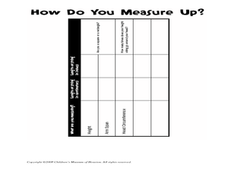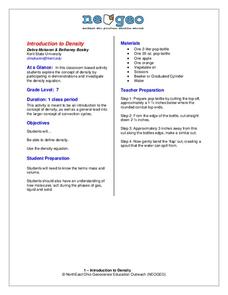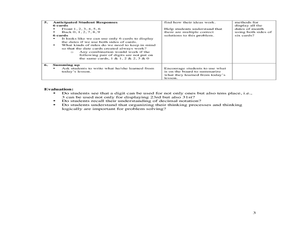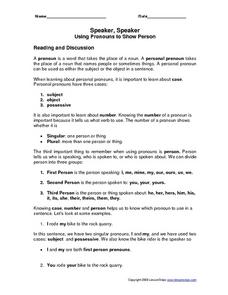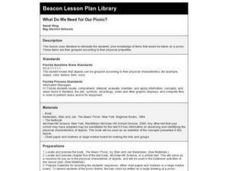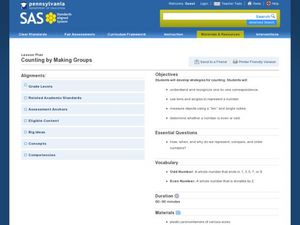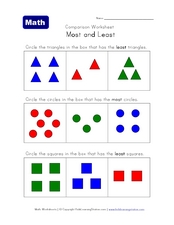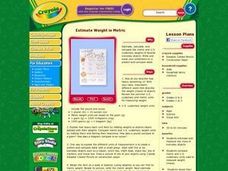Curated OER
How Do You Measure Up?
Students measure their body. In this measurement lesson, students use a string to measure their height and the circumference of their head. They record this information on the worksheet provided and answer questions as a group.
Curated OER
Beyond the AB Pattern in Dance
Students demonstrate various patterns using dance. In this expressive arts lesson, students are led in a warm-up to demonstrate the AAB pattern, which includes spinning and jumping. Students are broken up into groups and perform several...
Curated OER
Drama Terms Notes
Comedy, tragedy, act, scene, prop. do you want to review important drama terms? Actors record the term next to its definition on a worksheet that could be used individually or as a group activity. A link to a corresponding PowerPoint...
NorthEast Ohio Geoscience Education Outreach
Introduction to Density
Seventh grade scientists weigh in on the concept of density. In a nutshell, they participate in the following activities:
Measurement of the mass and volume of fruit in order to compare densities
Measurement of the mass of oil and water...
Curated OER
How many cards do we need to display the dates of the month on the wall?
Students determine how many number cards are needed to display the dates of the month. In this place value notation lesson, students write numbers on blank cards to see how many are needed of each number to makes all the dates...
Curated OER
Simple Machines, Odd Machine
Students examine levers and design a machine that uses a lever as a central component. In this lever machine lesson students test various machine designs and evaluate their effectiveness.
Curated OER
Speaker, Speaker: Using Pronouns to Show Person
In this pronouns instructional activity, learners fill in 12 blanks completing 7 facts about pronouns, read 8 sentences and determine if the underlined pronoun in each sentence is told in first, second or third person.
Curated OER
Numbers In Art
Students learn to identify numbers and to group objects in sets. The genre of artwork is used as a way of engaging students to develop this number skill. The creative project of making one's own hyperstudio card is made and this is where...
Curated OER
Simple Keys and Nutrition
Third graders identify descriptive questions as a method for distinguishing objects and for identifying labels for objects and categorizing objects. They participate in a student grouping activity, then using pictures of different types...
Curated OER
What Do We Need for Our Picnic?
First graders group objects according to physical characteristics.
Curated OER
Learning about the World of Color, Object and Shape Patterns
First graders practice identifying and creating patterns by using unifix cubes. In this visual design lesson plan, 1st graders investigate reoccurring patterns using colors and shapes and extend what is being made with their...
Curated OER
"Teaching with Material Objects" - Horn-book
Learners explore language arts by creating Venn Diagrams. In this reading materials lesson, students examine a horn-book and create a hypothesis about how to use it and where they derived from. Learners compare their horn-book to a text...
Curated OER
Counting by Making Groups
First graders represent, compare, and order numbers. In this counting skills lesson plan, 1st graders use manipulatives to demonstrate one-to-one correspondence and to represent numbers. This lesson plan includes a teacher script to...
Curated OER
Physical Properties of Group 1 Elements
In this elements worksheet, students complete a graphic organizer by filling in the symbol and atomic number for given elements. Students plot a graph of melting point against atomic number. Students write the electron arrangements for...
Curated OER
Vibrating Objects Produce Sound
Students use many different materials and resources in order to study and identify sounds that are loud or soft, high or low, pleasant or unpleasant.
Curated OER
Deciphering the Mechanics of Poetry
After a review of poetic terms, groups are given an object and they create a poem using a simile, a metaphor, internal rhyme, end rhyme, alliteration, and personification. Groups then exchange objects and repeat the process. Consider...
Curated OER
Comparison Worksheet: Most and Least
In this counting and comparing numbers worksheet, students count the object groups in 3 problems. Students identify the group in each problem that has more objects than the other 2 groups.
Curated OER
Find the Shorter Item
In this early childhood size comparison worksheet, students examine the 4 groupings of objects and circle the shortest object in each of the 4 groupings.
Curated OER
"If you build it..."
Students utilize prior knowledge to erect and assemble a building from a drawing using spaghetti noodles and marshmallows. In this building lesson plan, students visualize a three dimensional structure from looking at a picture and...
Curated OER
Paper Folding to Make Cubes
Examine patterns of figures composed of six-squares and predict which of the twenty presented could be folded to make a cube. They then fold large-scale patterns of these figures to confirm their hunches.
Curated OER
Estimate Weight In Metric
Students brainstorm words that describe the weight of objects. They pick up objects and estimate the weight. Afterward, students find the exact weight and compare U.S. units of weight to metric units. In groups, students create a chart...
Curated OER
Counting 1,2,3,4,5
In this counting worksheet, learners count ten groups of objects and circle the number that tells how many are in each group. Amounts of each item vary from one through five.
Curated OER
Reason for the Seasons
Young scientists examine why we have seasons on Earth, and how the motion of the Earth around the Sun causes them. Groups of learners are given a variety of balls, a bamboo stick, a marker, and a flashlight, then use the objects to...
Curated OER
Shapes in Motion
Students practice moving different shaped objects through a series of transformations. In groups, they discuss other ways to manipulate the figure to achieve the same results. They solve multiple story problems in the same manner.


